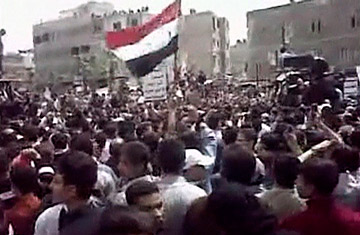
Demonstrators call for freedom at the funeral of eight protesters in the Damascus suburb of Douma, in this image taken from an April 3, 2011, video
Syria could very well learn its fate this Friday. According to a source from the country with close ties to the regime, if large-scale demonstrations break out after midday prayer in Syria's two largest cities, Damascus and Aleppo, the regime will be faced with a stark choice: either crack down with unlimited violence, or meet the demonstrators' demands. In either case, Syria is looking into an abyss.
The regime is in uncharted waters. In 1982 President Hafez Assad, the father of the current President, ordered the shelling of the town of Hama, killing more than 10,000 people to put down an uprising of the Muslim Brotherhood, because he was worried about a general uprising of Sunnis against the minority Alawites, who rule Syria. Assad feared that the Alawites would not only be driven from power but also face a real risk of slaughter. His son Bashar has apparently ruled that move out, if for no other reason than because it is unlikely to turn the tide as it did in 1982. Indeed, President Bashar Assad appears to be trying to calm the public anger. On Thursday, he met with a large delegation from the town of Dara'a, the center of the demonstrations. On Thursday, Assad also announced the formation of a new government with the appointment of Adel Safer, the former Agriculture minister, as the new premier. The former government had resigned in the wake of last month's protests.
In March, the regime had said as well that it would study whether to lift the 1963 emergency laws and perhaps hold elections. But many Syrians see all these moves as half-measures, noting that any prime minister or government administration has little efficacy when the President enjoys authoritarian power. And so the populace has kept coming out to protest Friday after Friday in more and more cities with each passing week. I asked my Syrian friend what will happen if this Friday goes badly. He said, "There are a lot of people on the inside who are asking how many more bad Fridays Bashar can survive. Two? Three? Who knows."
What's really rattled the President is the fact that the demonstrations have turned decidedly sectarian. The demonstrators are laying all Syria's problems, from corruption to unemployment, at the feet of the Alawites — the sect that Assad and his family belong to. The Alawites, who are an offshoot of Shi'ite Islam, make up only 12% to 14% of Syria's population, yet they have ruled Syria for more than 40 years, thanks to a tight grip on the military and security services.
The complaint most widely voiced by the demonstrators is corruption. But although the Alawites are a party to the problem, the Sunni elite enjoys its fair share. The real trouble between the Sunnis and the Alawites is that Sunni fundamentalists consider Alawites heretics, unqualified to govern a Muslim country like Syria.
Assad is hamstrung by the idea of relaxing his autocratic rule because the only group organized and popular enough to benefit from such a Syrian perestroika is the outlawed Muslim Brotherhood, which Damascus believes is fomenting trouble from enclaves in neighboring Lebanon. In fact, according to my friend, Syria last year considered using armed forces against Tripoli to clear out the Brotherhood in that Lebanese city.
The sporadic clashes this week between protesters and security forces in the coastal town of Baniyas have only fueled the regime's fears. Baniyas has long been known as a hotbed for Islamic militants, and it could turn volatile, because weapons are easily smuggled across the porous border with Lebanon. The Islamist theme has thus been sounded from the very beginning of the uprising. Dara'a, the town where the original demonstrations broke out, is also known for its conservative Sunni politics.
Baer, a former Middle East CIA field officer, is TIME.com's intelligence columnist and the author of See No Evil and, most recently, The Devil We Know: Dealing with the New Iranian Superpower.
